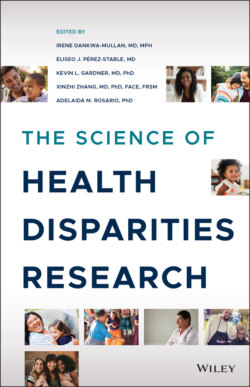Читать книгу The Science of Health Disparities Research - Группа авторов - Страница 19
1.3.5 Standardized Measures of Minority Health‐ and Health Disparities‐Related Constructs
ОглавлениеEvaluation of health disparities by SES requires a consistent and reliable approach. Household income is a powerful predictor of overall mortality in the United States, with those at the poverty level (defined as ≤ $25 000 household income per year) being three times more likely to die from any cause compared to the mortality rate among persons in a household with an income ≥ $115 000 per year (Figure 1.2) [9]. Although household income is a useful measure of SES, formal years of education may be simpler to obtain, more reliable and stable over the life course, and overall more efficient. Education may also be incorrectly reported, and years of schooling do not equate to quality of education. Thus, depending on the research question at hand, multiple indicators of SES may be the best strategy [10]. This relationship of SES measures and health outcomes is most robust for Whites and Blacks, but there is evident interaction between SES and race/ethnicity that needs to be inherent in most studies focused on minority health and health disparities.
Figure 1.2 Relative risk of all‐cause mortality by US annual household income level.
Although health disparities are usually related to SES and traditional minority race/ethnic groups, people living in rural areas are also a minority in their own way. There is increasing evidence of disparities from the leading causes of death among persons living in the most rural areas compared to those living in cities and these disparities merit increased research attention [11]. The operational definition of rurality used in data reported from the Centers for Disease Control and Prevention categorized about 18% of the US population as residing in rural counties. NIMHD endorses this definition and encourages researchers to examine the intersectionality of rural residence, less privileged SES, and race/ethnic minorities.
The addition of sexual and gender minorities (SGM) as a health disparity population is expected to lead to more innovative research to examine health determinants that contribute to disparities. SGM populations share the experience of discrimination with other disparity populations. This implies that there may be shared mechanisms of health determinants to specific conditions that can be examined. Although sexual orientation and gender identity questions are more recent additions to national surveys, it is clear that how these questions are asked significantly affects how respondents identify themselves. More research is needed to understand the best ways to assess sexual orientation and gender identity.
In comparing outcomes across populations, it is important to use standard terminology. Disease or condition rates, important aspects of morbidity, are typically described in terms of incidence and/or prevalence and are important components of population morbidity. Population health is often measured by mortality, so researchers will frequently evaluate not only rates, but also whether a population has premature and/or excessive mortality for specific conditions. Using a general index that reflects population health—such as a global burden of disease measured by disability‐adjusted life years (DALYS) or premature years of life lost—can provide insights into understanding mortality patterns in areas where populations vary [12].
For clinicians, rates of risk factors such as level of blood pressure, health‐related behaviors such as cigarette smoking, and biomarkers linked to disease outcomes such as glycosylated hemoglobin for diabetes are important components of population morbidity directly in the causal pathway of disease incidence. For clinicians and social scientists, the assessment of how patients or people feel and function using standardized measures provides important data and outcomes to consider. Such outcomes could include psychometrically tested symptom scores for specific conditions, quality of life measures, and activities of daily living. The interdisciplinary nature of minority health and health disparities science will benefit from concurrence on standardized terminology and measures.
